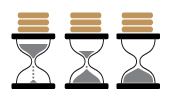
| An ETF Portfolio
Ready-made ETF portfolios are usually thematic and could include up to 10 or more ETFs adding diversity such as expanded geographical access or exposure to desired asset classes.
These portfolios are often curated by a team of investment experts, who monitors and rebalances as market conditions change for optimal performance. And are usually available at a fraction of the cost, if you had attempt to replicate the portfolio using the same underlying assets. |

| Regular Savings Plan
Alternatively, if you prefer regularity – a fixed sum from S$100 on a monthly basis, and investing that’s fuss free, consider a Regular Savings Plan (RSP).
An RSP for ETF keeps investment decisions simple – you determine the sum of dollars you’d like to set aside every month and your choice of ETF. Set it up using iBanking and you can start accumulating your investments progressively and steadily.
No need to time the market with Dollar-Cost Averaging
The fixed sum goes into buying the same choice of ETF on a specified date every month, regardless of market conditions and unit price. This investment strategy, known as Dollar-cost Averaging, gets you more ETF units when prices are low and lesser units when prices are high. Over time, the average cost of your investment could potentially be lower versus a one-time, lump sum investment. |